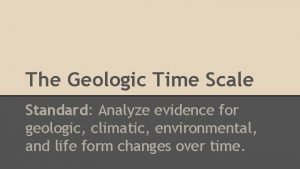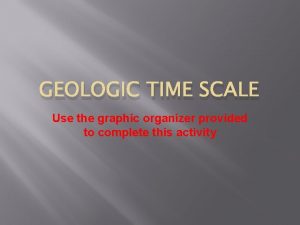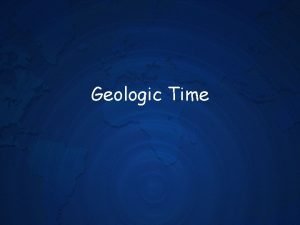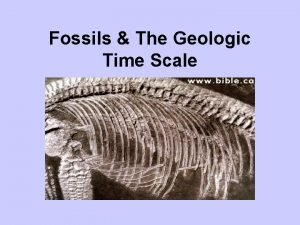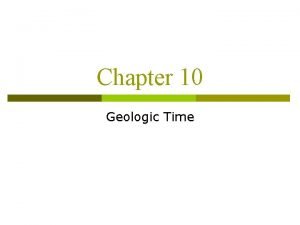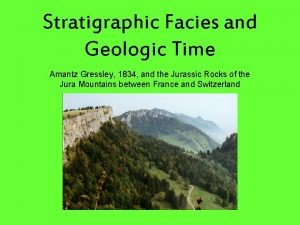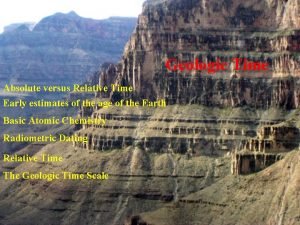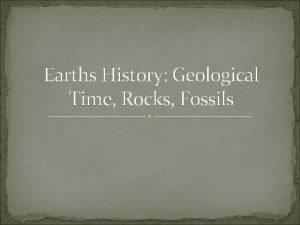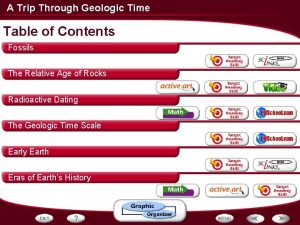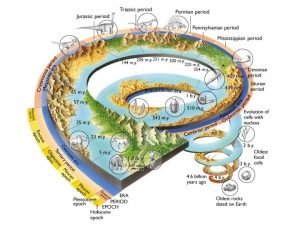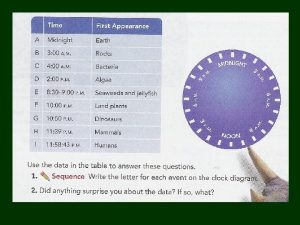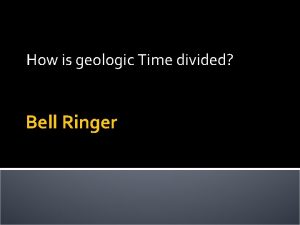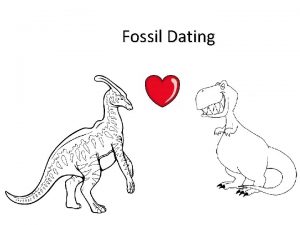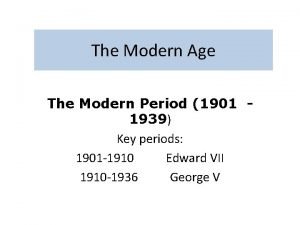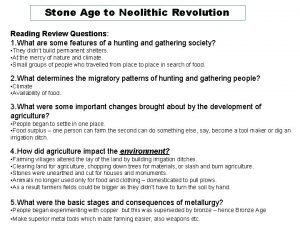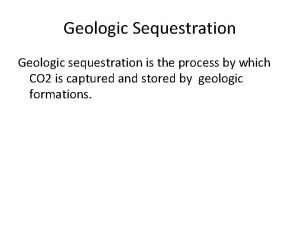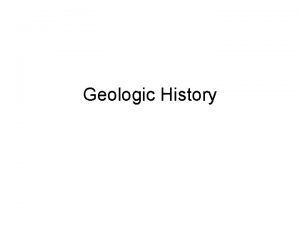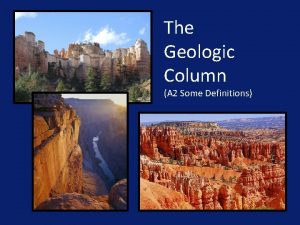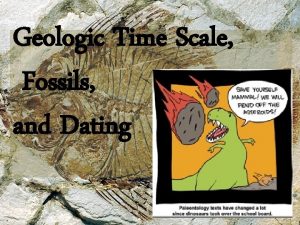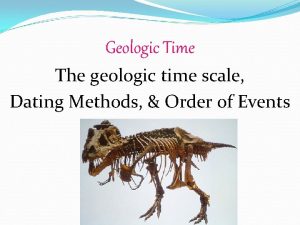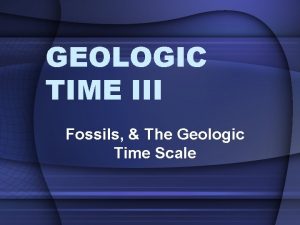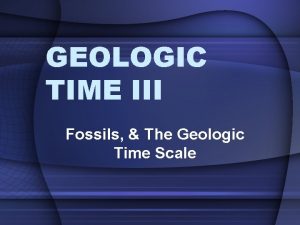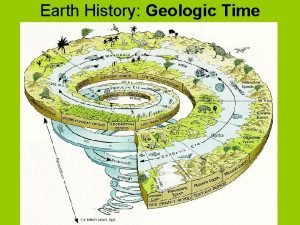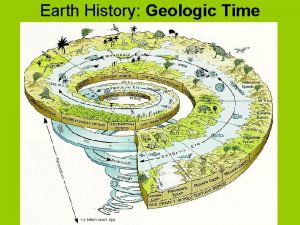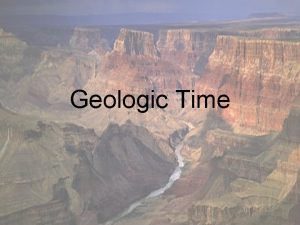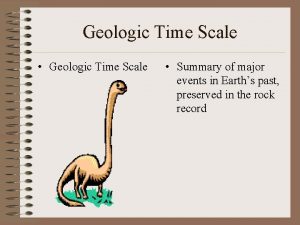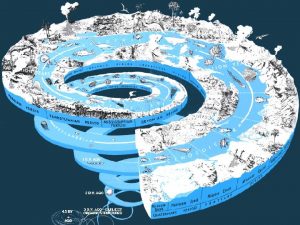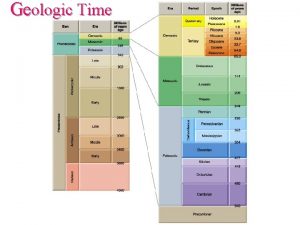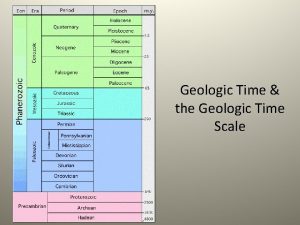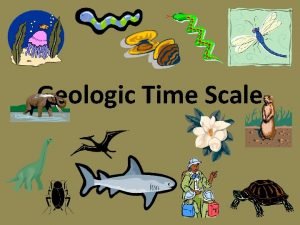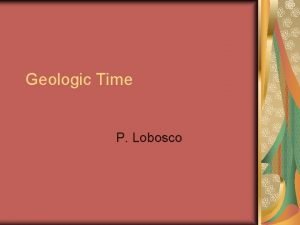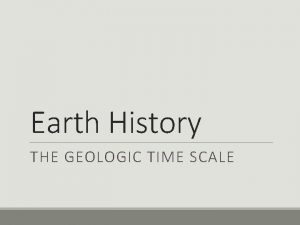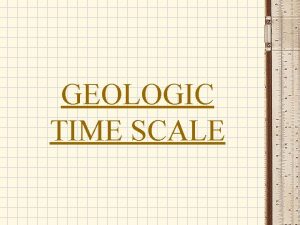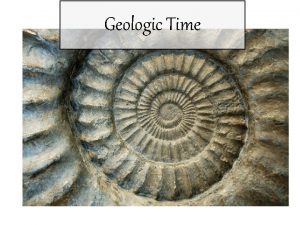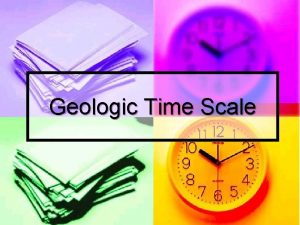Fossils Age Dating and Geologic Time Scale Fossils































- Slides: 31

Fossils, Age Dating and Geologic Time Scale

Fossils Traces and remains of ancient, often extinct, life are preserved in sedimentary rocks.

Did you know…? • Evidence of ancient, often extinct life is preserved in many sedimentary rocks! • Remember: – Extinct – no longer existing – Preserve – to keep from decomposing Photograph from http: //reptilians. org/home/kids_zone/fossil%20 turtle. jpg

What are Fossils? • Fossil – the remains, impression or other evidence of ancient life preserved in rock • Life forms stand a better chance of becoming fossils if – They have hard parts like bones, a shell, or teeth – The organism is buried quickly in sediment Photo from http: //www. ideofact. com/archives/trilobite. jpg

Types of Fossils • Original bone or shell – Organism becomes trapped in amber or tar • Molds – Hard parts are buried, decays or dissolved, leaving a cavity in the rock behind • Casts – Molds are filled in by sediment

Types of Fossils Original body parts Cast Mold Photos from Spider in amber http: //scienceviews. com/photo/thumb/SIA 0618. jpg Petrified wood http: //www. yourgemologist. com/Kids/petrifiedwood/wood. jpeg Graptolites http: //www. premdesign. com/clilrg. jpg Ammonite mold http: //www. ammonoid. com/mcstrob-m. jpg Cephalapod cast http: //www. humboldt. edu/~natmus/Case_indexes/Case_jpgs/Make. Fossil. web/F-08. jpg Dinosaur track http: //www. delargy. com/images/2004_7_Colorado/dinosaur%20 footprint. JPG

Evolution of Life • Fossil evidence shows that life forms have changed and become more complex over geologic time Organisms become more complex over time Diagram from http: //www. cybered. net/library/Teaching_Resources/Biology/Evolution/Image_Gallery/Evolution-Fossil. Evidence. jpg

Fossils in Virginia • Most Virginia fossils are marine organisms. • This indicates that large areas of the state have been periodically covered by seawater in the past. • Virginia fossils range in age from 8, 000 years to 544 million years old! Whale fossil from the Mioceneaged Eastover Formation in New Kent County Fossil shells from VIrginia (Photos from http: //www. wm. edu/geology/virginia/coastal_plain_fossils. html)

Fossils in Virginia • Fossils are found mainly in these geological provinces of Virginia: • These fossils are from the Paleozoic, Mesozoic, and Cenozoic Eras. Piedmont Valley and Ridge Appalachian Plateau Blue Ridge Coastal Plain Map from http: //www. mme. state. va. us/Dmr/DOCS/Geol/vageo. html

Relative and Absolute Age Dating • Superposition, cross-cutting relationships, index fossils, and radioactive decay are methods of dating bodies of rock. • Absolute and relative dating have different applications but can be used together to determine the age of rocks and structures.

Did you know…? • The Earth is very ancient – about 4. 6 billion years old • Uranium-lead dating of zircon crystals in meteorites was the method used to determine the age

Relative Age Dating • The relative age of something is its age in comparison to the age of other things. – For example, I am older than you and you are older than an elementary student so I know about how old you are. Photo from http: //www. rif. org/assets/Images/photos/adult_child_reading. jpg

Relative Age Dating • Geologists determine the relative ages of rocks and geologic structures by examining their place in a sequence. – If you stack all the textbooks up in one stack, the on the bottom had to be put there first… – If you tear a piece of paper, the piece of paper had to be there before the tear Photo from http: //www. learning-for-living. co. uk/website/images/TESTgloss. jpg

Determining Relative Age for Rocks • Fossils – A layer of rock can be no older than the age of the fossils embedded in it http: //www. geology. ohio-state. edu/~vonfrese/gs 100/lect 29/xfig 29_04. jpg

Determining Relative Age for Rocks • Principle of Superposition – Older rocks lie underneath younger rocks in areas where the rocks haven’t been disturbed by faults and folds Photo from http: //earth. geol. ksu. edu/liu/g 100/figures/15_superposition. jpg

Determining Relative Age for Rocks • Unconformity – Gaps in the rock record – Area between layers that wasn’t laid down in an unbroken sequence Photo from http: //earth. geol. ksu. edu/liu/g 100/figures/15_superposition. jpg

Diagram from http: //www. gly. fsu. edu/~salters/GLY 1000/12 Rock_record_time/Slide 17. jpg

Determining Relative Age for Rocks • Principle of Crosscutting Relationships – Faults, folds, and igneous intrusions are always younger than the rocks they cut across. Diagram from http: //www. geol. umd. edu/~jmerck/eltfal 00/118 g/l 3/crosscutting 1. gif

Diagram from http: //www. gly. fsu. edu/~salters/GLY 1000/12 Rock_record_time/Slide 17. jpg

Recap of Relative Age Dating • Relative time places events in a sequence without assigning any numerical ages. – We don’t need to know the exact age of the rock or fossil to know about how old it is. • Fossils, superposition, and cross-cutting relations are used to determine the relative ages of rocks.

Absolute Age Dating • Absolute time places a numerical age on an event – Example: John is 16 years old • Radioactive decay is used to determine the absolute age of rocks Diagram from http: //www. cotf. edu/ete/images/modules/msese/earthsysflr/EFGeologic. P 11. gif


Absolute Age Dating • The half-life of a radioactive isotope is used to determine the time it takes for half of the atoms of the isotope to decay (turn into another isotope) – Carbon 12 to Carbon 14 • 5, 700 years – Uranium to Lead • 4. 5 billion years • Because half-lives don’t change, scientists can determine the approximate ages of rocks and minerals containing radioactive elements.

Geologic Time Scale

Geologic Time Scale • By using the methods of relative and absolute dating, scientists have been able to piece together a timeline of Earth’s history, called geologic time scale. • The geologic time scale includes both geologic events and major developments in the evolution of life.


Geologic Time Scale • The geologic time scale is divided into eons, eras, periods and epochs. • Eons are the largest division. • Earth’s entire history is divided into 2 major eons – Precambrian – time before complex life 88% of Earth’s History – Phanerozoic – Time after evolution of complex life

Geologic Time Scale • The Phanerozoic Eon is divided into 3 major Eras based on the types of animals that evolved during those times. • Paleozoic – Age of the Fish • Mesozoic – Age of the Reptile • Cenozoic – Age of the Mammal

Geologic Time Scale • Eras are divided into periods and periods are divided into epochs based upon geologic events, environmental conditions and life forms • Only the Cenozoic Era, the most recent, contains epochs because of the abundance of evidence.


Mass Extinctions?
 Compare geologic time with the geologic column.
Compare geologic time with the geologic column. How is the geologic time scale organized
How is the geologic time scale organized Geologic time scale graphic organizer
Geologic time scale graphic organizer Geologic time scale in a calendar year
Geologic time scale in a calendar year Geologic time scale animals
Geologic time scale animals Geologic time scale drawing
Geologic time scale drawing Moth scale
Moth scale Nooa
Nooa Facies
Facies Geologic time scale poem
Geologic time scale poem Geologic time scale
Geologic time scale Geologic time scale drawing
Geologic time scale drawing Obj dating
Obj dating How fossils are dated
How fossils are dated Iron age dates
Iron age dates Iron age bronze age stone age timeline
Iron age bronze age stone age timeline Fossils
Fossils Geologic time
Geologic time 4 divisions of geologic time
4 divisions of geologic time Geologic time
Geologic time What is the longest subdivision in geologic time
What is the longest subdivision in geologic time Chapter 12 geologic time
Chapter 12 geologic time Formula for carbon dating
Formula for carbon dating Relative age of rocks diagram
Relative age of rocks diagram What is absolute dating
What is absolute dating Example of elapsed time
Example of elapsed time Victorian age and modern age
Victorian age and modern age Difference between stone age and modern age
Difference between stone age and modern age Romanticism vs victorianism
Romanticism vs victorianism Geologic sequestration
Geologic sequestration Geologic history meaning
Geologic history meaning Geologic column definition
Geologic column definition

